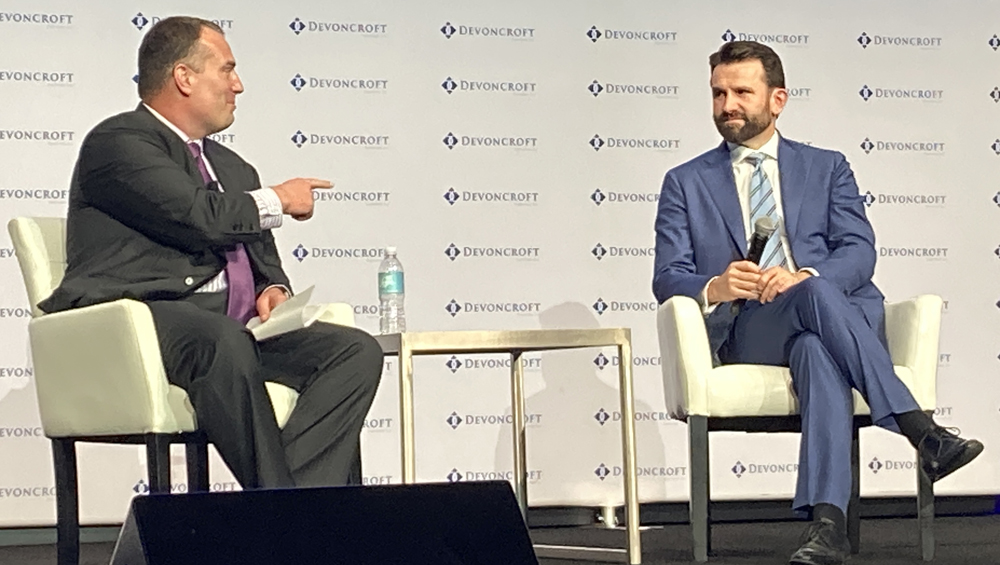
Broadcasters, Vendors Tout Cloud Progress At Devoncroft

LAS VEGAS — After a break of more than three years due to the COVID-19 pandemic, broadcasters and technology vendors once again gathered in person in Las Vegas on Saturday to discuss the current state of media technology investment at Devoncroft Partners’ annual Executive Summit.
“To say we’re excited to be here is an understatement,” said Joe Zaller, founder and president of the San Diego-based research firm, which filled the gap with virtual events in late 2020 and 2021.
While previous Devoncroft conferences took place at off-site hotels, the 2022 edition was co-located with the NAB Show and held on the Main Stage of the North Hall at the Las Vegas Convention Center. It drew hundreds of senior executives for an afternoon of panel discussions on everything from cloud migration and IP connectivity to virtual production and blockchain technology. While perhaps 25% of the audience wore face masks, the Summit had very much a pre-pandemic field, with attendees enjoying spirited conversation during the networking breaks.
Streaming Envy Has Dimmed
In recent years, the rapid proliferation of streaming services has, of course, dominated the conversation about the media industry in the mainstream press, on Wall Street and in the industry itself. Not surprisingly, OTT [multiplatform content delivery] has been cited by respondents to Devoncroft’s “Big Broadcast Survey” of key broadcast customers as the No. 1 trend every year but one since 2011.
But as streaming services like Netflix and Apple TV+ have continued to pump billions into content production and broadcast and cable networks have launched their own streaming products to compete, Devoncroft Principal Analyst Josh Stinehour has made the case that media companies should focus more on investing in technology than simply producing more content, a point he reiterated Saturday.
“Your next dollar spent on technology will have a higher return than your next dollar spent on content,” said Stinehour, who also suggested that “envy” of soaring valuations for streamers like Netflix in the past decade have informed some big media companies’ strategic decisions to spend big on streaming.
Stinehour may have an easier time making his case in light of the recent plight of Netflix, which saw its stock drop 35% last Wednesday after announcing it lost subscribers in the first quarter. He showed a chart displaying the 58% drop in Netflix’s stock from Oct. 29, 2021, to April 21, 2022, a $215 billion decline in market cap.
“This bubble has burst, it’s over, it’s gone,” he said. “Now we can have all kinds of conversations again without that loud voice of envy — getting back to multiple business lines, and how we drive forward and monetize content in other ways.”
So where should media companies focus their technology investment? “IP networking and content delivery” is the No. 2 trend in the Devoncroft survey. But Stinehour noted that when you drill into the numbers more closely, systems integrators and vendors are far more bullish on IP routing than the end customers themselves. He said that makes sense, as difficulties in implementing the new technology have helped sustain revenues for both of those parties. He also cited alternatives like NDI, a compressed networking technology originally developed by NewTek and now being broadly promoted by Vizrt.
“Do you see happiness in the early adopters of 2110? You do not see happiness,” said Stinehour. “So anywhere where you see human misery, you will find billable hours. There are real opportunities to fix that.”
Sky’s The Limit With The Cloud
A technology sector where broadcasters are finding more initial success is the cloud, where major networks are moving key workflows from legacy on-premise hardware to software applications running on public cloud platforms like Amazon Web Services, Google Cloud and Microsoft Azure. Comparing the cloud migration to previous big technology shifts like the HD transition or the move to file-based workflows, Stinehour sees a much bigger payoff for broadcasters’ investment. And he expects the next 18 months “will be rather frenetic with the adoption.”
Besides giving programmers more flexibility to launch new services or modify existing ones than traditional hardware, cloud platforms also provide abundant data about how what resources they are using and how their businesses are performing. And in the case of corporate mergers or restructurings, they can also quickly replace legacy technology or solve lingering real estate problems.
Amagi is one of the companies benefiting the most from broadcasters’ investment in the cloud, particularly those using it to launch new FAST [free ad-supported streaming TV] channels. The company recently raised another $95 million in venture-capital financing and just struck a deal with Cox Media to help it launch 30 news-based FAST channels across 10 markets.
“The market has been fantastic,” said Amagi co-founder Srinivasan KA. “We’ve been growing at over 100% year-on-year over the last two years. What’s really helped us is this new evolution of that’s grown at a massive scale.”
Business has also been good for supply chain software vendor SDVI, which saw a big uptick last year in captioning and subtitling work for non-live programming being done in the cloud. The main reason was that SDVI’s large media customers keep doing more distribution deals with more platforms.
“We’re a virtualized infrastructure company, and clearly that came to the fore with COVID,” said SDVI Co-founder and CEO Larry Kaplan. “What we’re seeing is people equate a high-performance infrastructure with the consumer experience. So that’s really accelerated the market from our perspective in the last two years.”
The On-Premise To Cloud Shift
Shortly after the merger between CBS and Viacom closed in December 2019, the new ViacomCBS looked to the cloud as way to overhaul its business. In December 2020, the company, now called Paramount, announced a sweeping deal with Amazon Web Services making it “the preferred cloud provider” for its global broadcast media operations. As part of the agreement, Paramount is in the process of moving all of its broadcasting operations, including 425 linear television channels and 40 global data and media centers, to the AWS cloud.
“The biggest financial driver for our cloud migration was real estate,” said Paramount CTO Phil Wiser. “We had 40 global facilities for processing and distribution at different levels, and we were able to go in and show we could reduce that down to a handful.”
So far, the migration is going well. Paramount has already moved more than 100 channels to the AWS cloud and has another 100 in the queue for this year. And it has shut down several data centers, including a big playout facility in Amsterdam last week.
Being a business “in transformation around streaming” has helped Paramount, Wiser added. Beside moving linear channel playout to the cloud, Paramount has also moved its ad technology stack and media supply chain there as well.
Since it began its cloud migration Paramount has launched around a dozen channels, most recently a Nickelodeon kids channel aimed at serving Ukrainian children who have fled their country due to the war there. That new Ukrainian kids channel, distributed through both OTT (ad-supported Pluto TV channels) and linear platforms to neighboring regions, was created and spun up in a matter of weeks.
“Agility” is not only a major benefit of the cloud but a belief system in itself, said Wiser. “You have to have a belief system — all the way up to the C-suite and the board — that moving fast matters.”
Sinclair Broadcast Group also faced a technical overhaul when it acquired the regional sports networks formerly owned by Fox in the wake of the Fox-Disney merger, as Sinclair had to move the networks (now branded as Bally Sports) out of the technical plant at The Woodlands, Texas (now owned by Disney), by August 2021.
Sinclair wasn’t ready to replace that plant with public cloud, and instead tapped Encompass to build a new 2110-based playout facility in Atlanta. But it used the move to shift the RSNs’ archive — some 9 petabytes in all — to the AWS cloud, making that content readily available to all of Sinclair’s business lines. Sinclair also moved automation and playout of its national networks to the cloud in March 2020.
“A lot of that was the opportunity to learn,” said Sinclair SVP-CTO Mike Kralec. “The hidden gems there were just in the ability to pivot the business very quickly to new opportunities in those national networks. Bringing in live, bringing in additional channels, all that happened in days or weeks. It didn’t happen in months and years anymore.”
Kralec said that Stinehour’s bullish predictions of a large-scale move to cloud in the next two years may very well be correct, as lot of the technology leadership among broadcasters are driving toward cloud models and getting into the details of those operational workflows. He said the new “broadcast app” for ATSC 3.0 that Sinclair has developed and is making freely available is a good example of a technology that blurs the lines between the digital side and the linear side to provide interactivity, OTT content streams and additional data.
“I think we’re going to see a continuous move toward more cloud, and more workflows on cloud,” Kralec said. “And just a more precise application of technology to get rid of some of that legacy, and to bring us into a more agile environment.”
































Comments (0)